

Food for thought
 |
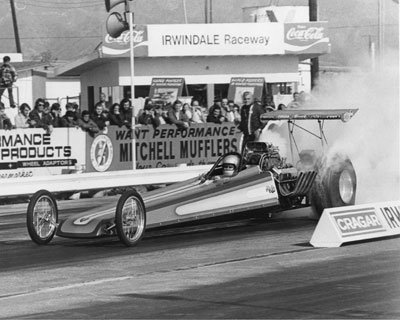 |
It may well be the most famous and photographed concession stand in drag race history, showing up in the background behind superstar racers burning rubber at Irwindale Raceway in the 1960s and ‘70s, and also Ground Beef Zero for any discussion about dragstrip food. This Irwindale snack bar, located behind the starting line on the right side of the famed Southern California raceplant, was in direct line of sight between the photographers’ area and the burnout box, and I’m guessing that a pretty sizeable percentage of photos ever shot at the ‘Dale had that concession stand in the frame. There were two concession stands at Irwindale, the one mentioned above and another on the other side of the track closer to the finish line, and I gotta believe that the lucky folks who got to work the starting-line stand had one of the best seats in the house ever enjoyed by a burger slinger.
So, why does Irwindale which closed in 1977, still hold such a high place in the pantheon of dragstrip food? Six simple letters: In-N-Out.
Even today, out-of-state race teams and others who flock to Pomona each year always seem to have one thing on their mind besides the racing: A Double-Double burger and fries from the iconic SoCal fast-food giant. And with good reason: In-N-Out’s impeccably crewed and tightly-run stores predictably serve up the best burgers on the planet. It’s that good. The menu is very short: burgers, fries, drinks -— the “we do one thing, but we do it very well” school of thought. (Regulars know can get variations of the basic items, such as ordering their burger or fries “animal-style”; extra spread, grilled onions, and other additions.)
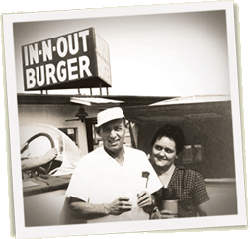 |
Founded in 1948 by Harry Snyder and his wife, Esther, In-N-Out remained pretty much a small (but cherished) Southern California secret for years — nearly 30 years after its founding, there were only 18 drive-thru stores — but a lot of racers and race fans who went to Irwindale (me included) probably never knew that the concessions stands were serving up In-N-Out burgers. The reason they were served there was simple and genius: Harry Snyder owned a 50 percent stake in Irwindale Raceway.
It’s such an important part of the In-N-Out story that it spans six pages in BusinessWeek writer Stacy Perman’s definitive book In-N-Out Burger: A Behind-the-Counter Look at the Fast-Food Chain That Breaks All the Rules. According to the book, a golfing buddy of Snyder’s convinced him in 1965 to invest in the newly-opened track. “The investment soon proved to be a canny move that further solidified the association between cars and In-N-Out that began with the drive-through,” wrote Perman.
Only about 10 In-N-Out stores existed then, all in the San Gabriel Valley, and serving the burgers at Irwindale — although they were never explicitly advertised as coming from In-N-Out — exposed them to a wider audience. I also read somewhere that In-N-Out used to promo upcoming Irwindale events with a flyer tucked in with your order, but I can't verify that.

(Above) Tim Grose, 1985 (Auto Imagery photo); (below) Melanie Troxel, 2011
|
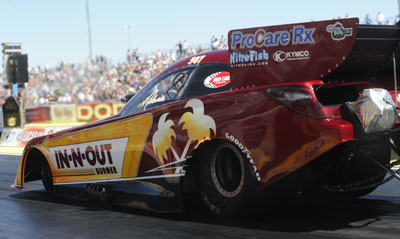 |
“Harry used his In-N-Out people to run the concessions, so burgers were identical, except they didn’t use tomatoes,” recalled Steve Gibbs, who managed the Irwindale track from 1966 to 1968. “Snyder built the In-N-Out empire on serving up good food at reasonable prices, and he saw to it that the Irwindale food was the same."
Snyder’s sons, Guy and Rich, worked the concessions stands and did other odd jobs for Gibbs, like handing out time slips, and being around the fast cars obviously led to their support of NHRA Drag Racing when they took over the company following the death of their father in 1976. The Snyder family sponsored Funny Cars, and Guy even raced quite successfully in Comp. Rich died in a plane crash in 1993, and Guy passed away in 1999, but the company’s support of drag racing continues today under the leadership of Lyndsi Martinez, Guy’s daughter and the lone grandchild of Esther and Harry, who took over the reins of the company after Esther died in 2006. Thanks to her passion for the sport, the company today sponsors Melanie Troxel’s R2B2 Funny Car.
“During that entire time I managed Irwindale, the food was Snyder’s/In-N-Out," said Gibbs. "He sold his interest not long after I moved on, but the Doner operation was smart enough to hang on to some good concession people and tried to maintain the same quality.”
According to the book, Snyder sold his interest in the racetrack around 1972 to concentrate on his growing empire. I asked Bill Doner, the notorious West Coast racetrack tycoon of the 1970s, about the post-Snyder years when he owned Irwindale, beginning that same year.
“Actually, we had a purchase contract with ‘Hamburger Harry,’ and he agreed to assist us with the concession food,” said Doner. “We kept a lot of the ex-In-N-Out workers on our payroll and in fact shifted a good portion of them to Orange County when we took it over [1975].”
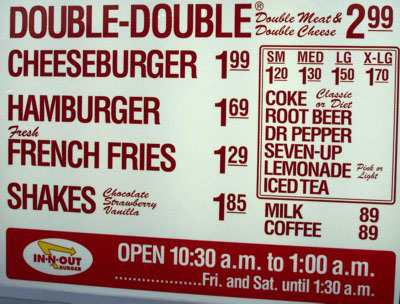
If you're looking for menu variety, this ain't the place; if you're looking for America's best burger, you found it. Thousands of drag fans can't be wrong.
|
Like any SGV kid, Gibbs grew up on In-N-Out goodness and quality. “In-N-Out has been a ‘way of life’ for many of us who grew up in the San Gabriel Valley,” he testified. “Gloria and I started dating in our junior year of high school and used to hang out at the original #1 In-N-Out [in Baldwin Park which recently — and sadly — was closed]. There’s more than 250 stores now and recently they moved into Texas with major expansion plans. My daughter works at one of the new Utah stores, in West Jordan.”
Photographer Jere Alhadeff, one of the great drag racing shooters of that era, also worked for Gibbs at Irwindale, and although he lived closer to Lions Drag Striip, his reasoning was simple. “I first went to Lions as a spectator while in high school and then was the track photographer," he said. "One thing was consistent: the food at Lion's was blah. I don't remember eating there more than once or twice. Fortunately, there was a great Italian deli, Santa Fe Importers, just a couple of miles away near Mickey Thompson's place. We always stopped there first.
"In the winter, Lions raced Saturday night, while Irwindale ran Sunday so I could go to both on the same weekend. Irwindale's food was unofficially In-N-Out Burger, so it was a gourmet's delight! I had always admired Steve Gibbs and he called and asked me if I'd like to be the Irwindale track photographer. At the time I was living in Newport Beach, so Lions was less than half the distance to Irwindale. However, Irwindale had In-N-Out! I told Steve I would do it for the same amount of money, plus two cheeseburgers!”
Growing up far from the San Gabriel Valley, a trip from my Culver City hometown to Irwindale with my stepfather seemed as long as a drive to the moon for this pre-teen (“Are we there yet?”), but eating at any concession stand was a treat because, back in those days kids, there wasn’t a fast-food joint on every corner and families just didn’t eat out that often, and if Mom was going to take a night off from the kitchen, we sure as heck weren’t going to the Golden Arches. That Irwindale’s food was that good was a super bonus.
Although today there are a half-dozen In-N-Outs within a few miles of my house (now don’t be hating), I was terribly deprived in my teen years because the nearest In-N-Out was a long drive away into the San Fernando Valley, at an In-N-Out in North Hollywood, where we’d stop after a night of cruising fabled Van Nuys Boulevard. I couldn’t have known it at the time, but years later, I would dine often at that same In-N-Out, which was just around the corner from NHRA’s headquarters when I joined the staff in 1982.
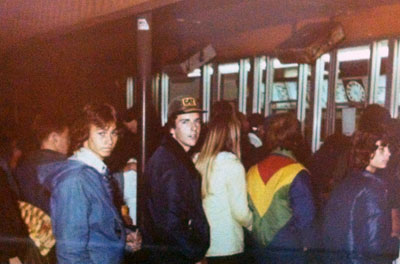
From The Burgess Photo Archives: The cat in the CAT hat is my best bro, future automotive journalism/TV superstar and muscle-car bon vivant C. Van Tune, in line for burgers at the OCIR concession stands. The preppy behind him? No clue.
|
Despite having a somewhat In-N-Out connection, my other main haunt, Orange County Int’l Raceway, couldn’t totally match Irwindale’s food but nonetheless left a lasting impression on my eating habits. Being a typical kid, I never ate onions on my burgers until one summer night at OCIR in the mid-1970s while we all waited interminably for “Leapin’ Larry” McMenamy to make what would be a final (and fatal) attempted leap on his go-kart over a row of parked cars (has there ever been a worse idea?). It was so damn cold and typically OCIR dewy that night that McMenamy’s plugs kept fouling. I was starving and cold, and with just enough money to buy a burger, I wanted every little morsel of the burger to starve off my rumbly tummy. I found that onions aren’t so bad, and while they’re still not a favorite condiment, every time I eat a burger with onions, I harken back to that night.
Mark Watkins, an Insider regular who shares so many of the same memories as me that I’m certain he’s the brother my parents traded for those 1971 PDA tickets, has has own great OCIR memories:
“In the mind of a 12-year-old drag racing fanatic, one of the best parts of a Saturday night at OCIR was when my dad sent me down to the concession stand (actually built under the pitside grandstands at about 300 feet out from the start line) to grab a burger for him and I. Nothing in the world tasted better. He made me pay for that burger, though. Later that night, I was the coffee mule for him and his pals. This was in the days before some genius invented the coffee lid. Try being 12 and carrying two or three coffees with no lids at a dragstrip with all of the hazards of large crowds, loud noise, and vibration. The penalty for sloshing coffee was pretty painful. I have to tell you, I would carry coffee all day to have just one day back at OCIR in the early ‘70s.”
OCIR also served up its nachos with optional hot sauce atop the cheese, and I simply can’t eat nachos any other way even today. I’m not alone in remembering the nachos.
Jerry Allen Hurd wrote, “I really miss the Super Gas Nachos from OCIR, their burgers were at times the best, but Irwindale fries created a craving I can't fill to this day!!! Maybe it was just being at the track that made the food better, but the tastes are just as strong in my memory as the sights and smells. It was the best of times.”
I told Jerry I thought they were called “Nitro Nachos” (a common usage even today). “I heard them many times being hawked at OCIR on the PA as Super Gas Nachos whenever the Sportsmen were there; Nitro Nachos for the Pro shows, as I remember it.”
Either way, I think it’s pretty funny — in a teenage boy kind of way — for any type of concession-stand food to be called Super Gas anything.
Topping off the SoCal triple-play was, of course, Lions Drag Strip. Stephen Justice worked in the concessions at Lions from 1962 to 1966, when the food and beverage concession was contracted to Harry Taylor (who was probably a Lions Club board member), who ran the concession with his wife and three adult children. He also would take issue with my earlier comment about the great view from the stand at Irwindale.
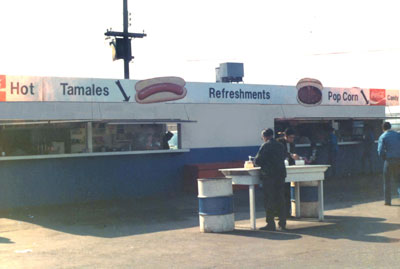
(Above) The main food stand shown in a photo from both a normal early Saturday or Sunday with only a couple of customers (Blanche Taylor photo) and (below) a night shot from the crowded Last Drag Race Dec. 2, 1972. (Kelly photo).
|
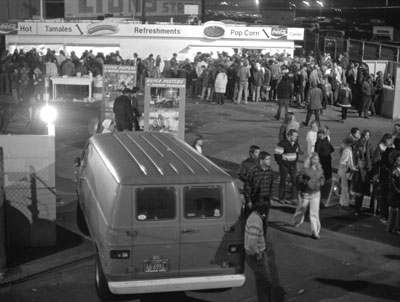 |
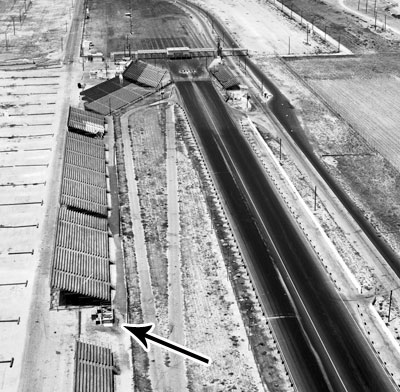
The arrow points to the mid-track stand on the west side, where Justice worked. (Don Gillespie collection)
|
“There was a main concession behind the grandstands, one in the pits, another one on the tower side close to the starting line, and two downtrack," Justice remembers. "I ran the stand on the west side at the eighth-mile point — absolutely and positively the best view to see the entire race at this strip. Harry was a kind gentleman who hired primarily young kids for his stands. It should also be mentioned that the Aumack brothers (later known for their gas and fuel dragster exploits in Northern California) were also employees of Taylor Concessions at that time. In fact, older brother Bruce was a ‘boss’ of sorts over us younger guys.
“So, what was the food like? OK. The hamburgers and cheeseburgers were not legendary like Irwindale but damn good by dragstrip standards. Everything was fresh, and the burgers were garnished with chopped lettuce and onion; no French fries but plenty of hot popcorn. Probably the item best liked by the fans was the tamale and homemade chili prepared by Harry’s wife. I have heard some negative comments about the t&c, but when I was there, I thought it was pretty good. There was no grill at the eighth-mile stand, so I did not have to cook burgers. I had a steamer and served hot dogs and chili dogs, soda, chips, and candy. It was a cool job: I saw the drags for free, ate for free, and met a lot of racers and fans. I also fed some of the racers from time to time; well, the ones I liked. On top of my list was Dave Beebe, who drove the Beebe-Vincent-Sixt Top Fuel dragster. Dave was the nicest guy ever and almost unbeatable at Lions during the summer of 1966. He would come down to my stand before eliminations with his wife and kid, and I made sure they were treated right. I left for college in October 1966, and that ended my little stint at Lions. I think it would be accurate to say that during that time I only missed one, maybe two races, in all those years. OK, two cheeseburgers, two popcorn, and two cokes — that’s $1.50, sir.”
Don Gillespie, whose three-part DVD documentary about Lions is a must for any fan, also worked the concessions at the famous strack at Alameda and 223rd Streets, and supplied the photos at right from his vast collection.
"I remember applying for a job with food concession owner Mr. Taylor, around age 15, especially to work in the main food stand near the starting line," he said. "While talking to him a Top Fuel car was fired up on the roller starters. My eyes were immediately glued on the smoke and fury just a handful of yards away. After all of the noise subsided, he politely said I would never be able to cut it. Why, I asked? ‘Because you're too interested in the cars,’ he stated flatly. Looking back, it never dawned on me to inquire about the other food stands there, especially the one at mid-track.
“As for my personal food intake, I was mowing lawns and pulling weeds -- anything just to be able to afford getting in to the track. Sometimes only a hot dog and/or Coke was all that it took (and all that I had) to keep me in hot rod heaven. Also purchased at their food stands was the latest copy of Drag News, which actually took precedence over the food! And a cup of hot chocolate in the wintertime, of course. Later, when I could afford a Drag News, hamburger, Coke, and a couple of the L&M Films wallet photos on a weekly basis, I knew I had moved up to the big time!”
Burgers certainly are a good part of any concession stand, but let’s be honest, when you think of dragstrip concession, you’re thinking primarily of the venerable hot dog or, as it’s become derisively known, the Drag Dog.

Of course I still have it!
|
Long before ZZ Top penned the song "Tube Steak Boogie" (probably not about hot dogs <g>), I first learned of that slang word for a hot dog in sixth grade, when I bought a book through that Scholastic Book Services program where elementary-school kids could buy mail-order books. My first was The Complete Book of Stock-Bodied Drag Racing, and it included a thorough (15 pages!) glossary of drag terms. It was written by Lyle Engel and the staff at Auto Racing magazine, but the foreword was written by Mike Doherty, who I didn’t know of at the time but who would become a god to me (and many of you) as publisher of Drag Racing USA, the Drag Racing Photo Greats books, and other great pieces of straight-line literature. Anyway, the entry there was “Tube steak — a hot dog; the main staple of a drag racer’s meal.”
Cliff Morgan, another SoCal drag veteran, knows the dog I’m talking about and relished the chance (see what I did there?) to reminisce about it.
“The infamous Drag Dog (or Drag Dawg, if yer in Texas),” he mused. “How many stories about people eating hot dogs at the strip and are close to death a few hours later? Ha! I remember once at Lions that I was in the pits, where the concession stand was, and ‘Snake’ comes up and gets a burger, or maybe it was a drag dog. I was astonished that Prudhomme actually ate at the concession stand. Figured he'd have his own food, but there he was. I can remember the concession stands at Irwindale, Lions, and OCIR, but not at San Fernando, which I think was a trailer. Never got sick from the food, though, at any track I ever ate at. My favorite track for food is Speedworld in Phoenix. Good food, not expensive, and it's a fun place to go to the drags. Try their breakfast special, SOS on scrambled eggs.”
While we’re dissing track food, here’s Peter Howell’s diatribe: “At da races, ‘Drag’ has a different meaning when it comes to food. 1) Expensive, as expected; 2) The condiments are warmed by the SUN, as expected ; 3) The burger patties are cold, as expected.; 4) The sodas are too cold, too much ice, as expected.; 5) Hot dogs are more of a phallic symbol than edible food, as expected.; 6) The small family racing teams serve their own WONDERFUL food and drinks, as appreciated!; 7) Eating at the concessions brings to mind another word: Diet.”
Don Hirsch wrote, “As a fellow Irwindale pit rat of the ‘70s, seeing a pit-side photo, with the In-N-Out stand (yeah, it didn't say In-N-Out, but we all knew) in the background always brings a smile. The bad thing is it set a standard that is tough to match. I would say of the many tracks I've been to, Pomona had food to be avoided if at all possible in the past, but to their credit, they now have many choices, and it's actually edible.”
 |
“Most dragstrip food I ever encountered was not worth remembering,” agreed Gibbs, “although one exception was the Italian sausage sandwiches that a guy named Leonard Beck used to serve up at Indy. I couldn’t wait for one of those, each return trip to the Nationals. The New family in Boise deserves a tip of the cap for giving their customers good quality food at very reasonable prices. All too often it’s the other way around.”
I, too, remember the Leonard Beck Experience, first introduced to me in 1983 by Leslie Lovett. As noted earlier, I’m not big on onions and had my sausage sandwich without additions that seemed to be enjoyed by the others. In a few years, I forged my own Indy tradition: a corn dog and a lemon shake-up. If hot dogs are bad for ya, then a corn dog has to be doubly bad, but it just reeks of carnival atmosphere. For those unfamiliar with the lemon shake-up, it’s probably equally as not good for you: A big cup of water, a heaping helping of sugar, and a squeezed lemon. They make it before your eyes, putting the ingredients into a cup, capping it with another cup, and shaking it to mix the ingredients together. Simple, yet effective. Today, a more health-conscious me limits myself to one Phil Burgess Indy Experience per visit.
OK, I can hear those of you who know me or who have traveled with me smirking about my “health-conscious” eating habits as I also find the inexplicable need to visit a Steak ‘n’ Shake in any racetown that has them (especially Indy and Gainesville) because we don’t have them out here; kinda like my reverse version of the In-N-Out phenomenon. I know I’m not alone in my S ‘n’ S addiction. Then there’s also Sonny’s Bar-B-Q, which is a Gainesville tradition for just about every racer I know. There’s one located just two miles from the track, and it’s packed every night during the Gatornationals.
Laura Bruederle, wife of longtime Midwest photog Mark, has her own sweet Indy memory. “Mark and I traveled to Indy, getting to the track early, racecars still snug in the trailers we would walk the pits," she remembers. "There calling us by the sweet smell of fried dough, we watched like two kids the magic machine squirting little circles of dough into hot boiling oil, and then the conveyor belt scooping them up and dropping them into either powered sugar or cinnamon sugar. The donut man then would scoop them up and put them into a white bag. We would get a large ice cold Pepsi and would have a breakfast that nothing has even come close to. I don't know if it was the perfect day to start a perfect race, or the perfect guy that i ended up marrying.”
But Indy is not the only sausage-lover’s heaven, according to John McLean, who remembers “the sweet smell of Italian sausage cooking away on the grills at E-town during the Summernationals — it doesn't get any better! From the ‘70s when the Summernationals was actually conducted in the heat of a July in New Jersey until the current version of a few months back, one of the consistent memories is sitting in those stands, be it spectator or pit side, and smelling that sausage grilling away. My mouth is watering.”

'Shake's' jambalaya and crawfish boil at the '83 Cajun Nationals. I understand a similar tradition continues today at the JEGS NHRA Cajun SPORTSnationals.
|
Another legendary NHRA food memory was never on the menu at State Capitol Dragway during the NHRA Cajun Nationals, but plenty of visitors to the Baton Rouge, La., track sampled the Louisiana delicacy of crawfish thanks to an after-hours get-together thrown by a guy known only to us as “Shake.”
“ 'Shake’s' claim to fame was his ‘Jambalaya by Shake,’ “ remembers Gibbs. “It was pretty good Cajun food ... when it came out right. He cooked the stuff in a giant metal pot, and I remember once, when he bought some bad onions, and he had to dump the entire batch, probably a few hundred pounds. They didn’t sell crawfish at the track, but 'Shake' would cook up a batch of the ‘mud bugs’ for a ‘private party’ around the base of the tower after Saturday night’s racing. Boy did it smell bad the next day!”
Mike McClelland, son of legendary announcer Dave, who had plenty of Louisiana roots, remembered the annual brain-sucking feast well. “At the 1982 Cajun Nationals, I asked what was in the jambalaya, which he made in about a 50-gallon kettle. His response: ‘If you gotta know what's in it, you don't want to eat it.’ Classic.”
I’ll pass.

Bret Kepner has made a career of visiting dragstrips (276 to date), so, as you might expect, he admits, “I’ve tasted a few straight-line snacks in my time,” but he clearly has his favorite drag delicacy.
“For just shy of 20 years, I spent each Memorial Day announcing the action at ‘Broadway Bob’ Metzler’s Great Lakes Dragaway in Union Grove, Wis. The concession area featured the infamous ‘beer garden,’ which included a bandstand and every conceivable food or beverage item. During a break at the Olympics in the early 1980s, I stumbled upon a little stand that sold what was advertised as Cocao Bars, pronounced ‘koh-CAY-oh.’ I instantly fell in love with this astonishing item and marveled at what remains to this day the largest ice cream bar I’ve ever seen. In fact, I’m not sure I can ever accurately describe the delight of a Broadway Bob Cocao Bar.
“Metzler’s track manager, the inimitable Mike Plantamura, called it ‘a bowl of ice cream on a stick’ and, although that’s exactly how I hawked them over the public address system, that was an understatement. A Cocao Bar was a brick-sized hunk (honestly) of mint-flavored ice cream on a stick dipped in an exorbitant amount of chocolate sauce and then rolled in crushed mixed nuts. It was not only heavenly but heavy; these things could barely be supported with one hand, and small children could barely balance them by the puny piece of wood protruding from the bottom of the bar.
"I can put away my fair share of sweets, but the Cocao Bar was so large I seldom could handle more than three in a 12-hour shift at the microphone. Regardless, they were ‘can’t-find-the-words’ delicious, and I asked 'Broadway' the origin of these magnificent treats. 'A farmer down the road makes ’em,’ he revealed, 'and I get ’em for next to nothing. They’re one of my highest-profit items, so sell a bunch of ’em for me.’ That task was certainly no problem. I loved these things, and I sold hundreds of them by coercion alone.
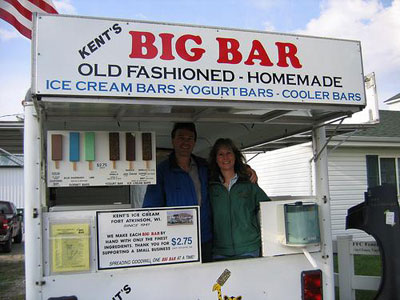
Kepner couldn't find them at Great Lakes, but Laura Bruederle found them online now as Kent's Big Bar at http://www.kentsbigbar.com/id2.html.
|
“My good friends, Mark and Laura Bruederle, would tease me about my love of Cocao Bars before I’d arrive for the Olympics each year. Mark was the track photographer for decades and had the opportunity to eat one every weekend, and he tortured me with that information whenever he could. They both knew how much I looked forward to grabbing one the minute I parked my car on the property.
“Around 1994, I drove up for my annual stint at the Olympics and, as soon as I could, headed immediately for the little shack that sold my beloved Cocao Bars. In an instant, my heart stopped when I realized the Cocoa Bar stand was gone. I rushed to the other concession buildings, but it quickly became apparent there were no Cocao Bars to be had. Horrified, I ran to ‘Broadway’s’ office and, in a near panic, asked why I couldn’t find any Cocao Bars at the track. Broadway responded with a quizzical look and a confused, ‘Huh?,’ to which I replied, ‘You know … the Cocao Bars! The gigantic ice cream bars dipped in chocolate and rolled in nuts! The ones the FARMER down the road makes for you every year!’
“ 'Broadway' suddenly realized what I was asking and, waving his hand as if to blow off my frantic query, said, ‘Oh! That guy? The FDA shut him down last winter.’ “
That’s the main course, for now. Have other culinary curiosities or dragstrip delights to share? Dish ‘em out, and I’ll serve ‘em up for our hungry audience here for dessert.



















































